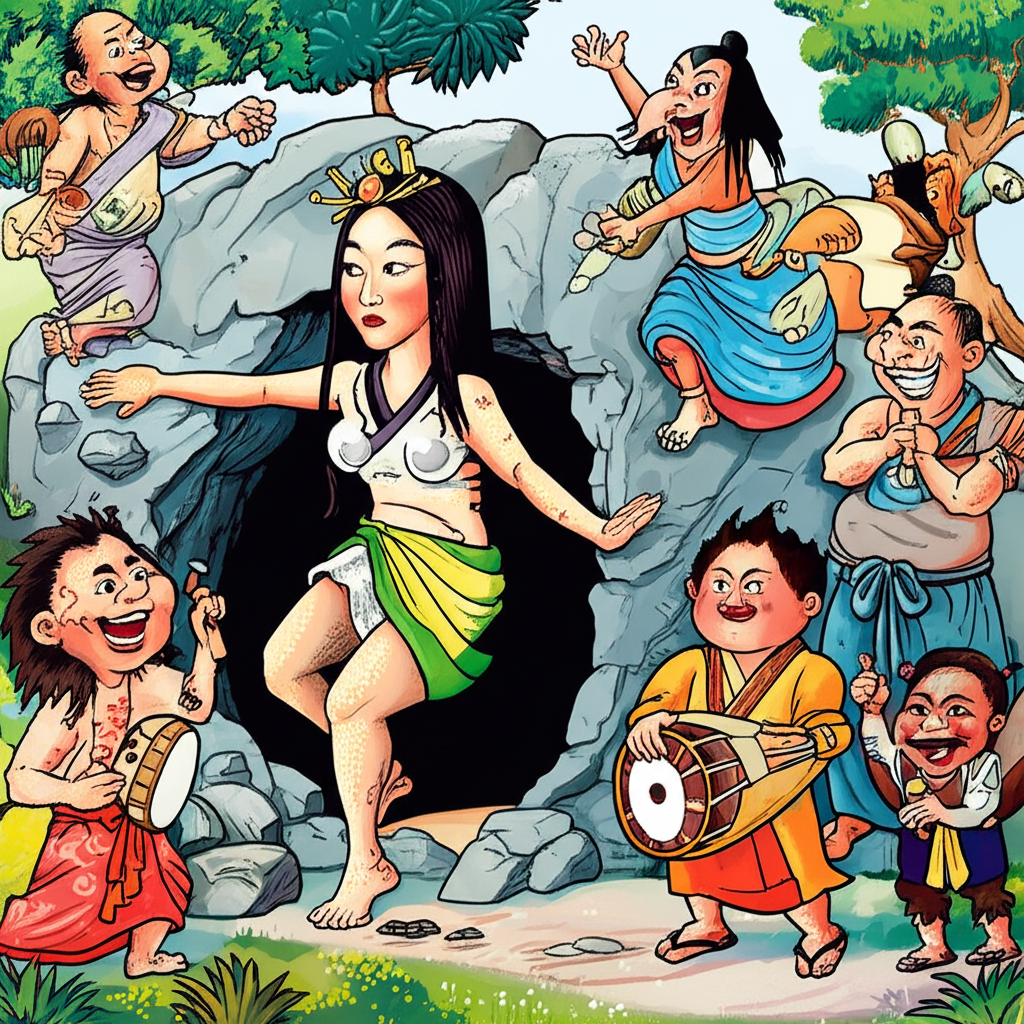
Introduction:
The tale of Amaterasu, the radiant sun goddess, and her self-imposed exile in a cave, is a cornerstone of Japanese mythology, specifically stemming from the ancient narratives recorded in the Kojiki (Records of Ancient Matters) and the Nihon Shoki (Chronicles of Japan). These texts, compiled in the 8th century CE, offer a glimpse into the beliefs, values, and worldview of the people of early Japan. It is essential to remember that this is a traditional story, a product of human imagination and storytelling passed down through generations. It is not meant to be a factual account but rather a window into the cultural heritage of a specific time and place.
Origins and Cultural Background:
The stories of Amaterasu and the other kami (gods and spirits) flourished during a period of significant social and political transformation in ancient Japan. This era, encompassing the Yamato period (c. 250-710 CE) and beyond, saw the rise of a centralized court and the development of a distinct Japanese identity. The environment was largely agrarian, with rice cultivation forming the economic foundation. Life was deeply intertwined with the natural world, and the sun, the moon, the mountains, the rivers, and even specific trees were often imbued with spiritual significance.
The people of this time understood the world through a lens of animism, believing that spirits resided in all things. They saw a connection between the human realm and the unseen world of the kami, and sought to maintain harmony between the two through rituals, offerings, and reverence. The rulers of the time, the emperors, claimed descent from Amaterasu, solidifying their divine authority and connecting their rule to the cosmic order. The myths served to explain the origins of the world, the creation of humanity, and the relationship between the people and their deities, providing a framework for their understanding of existence and their place within it.
Character/Creature Description:
Amaterasu-ōmikami, whose name translates to "Great August Kami Who Shines in the Heavens," is the central figure in this narrative. She is the sun goddess, the embodiment of light, warmth, and life. She is depicted as a radiant and benevolent deity, associated with the life-giving properties of the sun. While she is often portrayed as a powerful and respected figure, the story also reveals her vulnerability and her emotional responses, showcasing her as not just a divine being but also a figure with human-like qualities. Her brother, Susanoo-no-Mikoto, the storm god, is a more volatile figure, representing chaos and destructive power. The tale contrasts the order and serenity associated with Amaterasu with the turbulent nature of Susanoo.
Main Story/Narrative Retelling:
The story begins with Susanoo, Amaterasu’s brother, wreaking havoc in the heavens. Filled with grief over the loss of his mother, he unleashes his fury upon the celestial plains. He destroys rice fields, defiles sacred places, and even hurls a flayed pony at his sister’s weaving hall. Ashamed and distraught by his behavior, Amaterasu retreats into the Heavenly Rock Cave, Amano-Iwato, plunging the world into darkness.
The world falls into chaos. The light vanishes, and the kami are plunged into a state of panic. The crops fail to grow, and the natural order is disrupted. The other deities, led by the resourceful Omoikane, the god of wisdom, convene to devise a plan to lure Amaterasu out of her hiding place.
They gather at the mouth of the cave and begin a grand celebration. A female deity, Ame-no-Uzume-no-Mikoto, the goddess of dawn and merriment, performs a raucous and suggestive dance. She beats time with her feet and claps her hands, and the other deities erupt in laughter and joyous cries.
Intrigued by the commotion outside, Amaterasu peeks out of the cave, wondering what could be causing such mirth in the darkened world. A mirror is held up, reflecting her own radiant image, and she is further drawn out by her curiosity. As she emerges slightly, the other kami quickly seize the opportunity. They pull her out of the cave, and light floods back into the world. The sun goddess’s return brings an end to the darkness, and the world is restored to its former glory. Susanoo, for his actions, is banished from the heavens. He descends to the earthly realm, where he eventually battles and slays the fearsome serpent, Yamata no Orochi.
Symbolism and Meaning:
The story of Amaterasu’s cave is rich with symbolic meaning. The retreat into the cave can be interpreted as representing the withdrawal of light, the loss of order, and the disruption of the natural world when the sun’s influence is absent. Amaterasu’s return symbolizes the return of life, hope, and prosperity. The story reflects the importance of harmony and balance in the universe, emphasizing the need to maintain order and avoid chaos.
The actions of Susanoo can be seen as representing destructive forces and emotional turmoil. The dance of Ame-no-Uzume, with its suggestive nature, may symbolize the power of joy, celebration, and the power of feminine energy to overcome darkness and despair. The mirror, a key element in the story, represents self-awareness and the recognition of one’s own beauty and power.
The story also reflects the social hierarchy and values of the time. The council of kami and their collective effort to restore order underscores the importance of cooperation and leadership. The actions of the deities also reflect the human emotions of grief, anger, curiosity, and joy.
Modern Perspective:
The myth of Amaterasu’s cave continues to resonate in modern times. It appears in various forms in literature, film, video games, and other cultural products. The story’s themes of light versus darkness, chaos versus order, and the importance of hope and resilience are universally relatable.
In modern interpretations, the story has been explored in various artistic forms, including anime and manga, such as the Naruto franchise where the technique is a powerful visual representation of the sun goddess. The themes of perseverance and the power of light to overcome darkness continue to hold appeal. It also serves as a reminder of the cultural heritage of Japan, connecting modern audiences to the beliefs and values of their ancestors.
Conclusion:
The tale of Amaterasu’s cave is a powerful and enduring myth, a cultural artifact that offers a glimpse into the worldview of ancient Japan. It is a story of imagination, storytelling, and the human desire to understand the world and our place within it. We acknowledge that, as Muslims, we recognize that only Allah is the true Creator and Sustainer.
This myth, like many others, reminds us of the power of storytelling to preserve cultural heritage and transmit values across generations. It encourages us to appreciate the diversity of human cultures and to recognize the importance of imagination in shaping our understanding of the world. It provides a valuable window into the past, offering insights into the beliefs and aspirations of a civilization far removed from our own, while still providing universal themes that remain relevant and thought-provoking today.





